Impact of Maker Movement on the Urban Resilience Development: Assessment Methodology and Analysis of EU Research and Innovation Projects
Abstract
:1. Introduction
- To identify and characterize the EU-funded projects related to maker practices applied to urban development.
- To study the common trends in research and innovation in the field at the European level.
- Inclusiveness intended as multistakeholder participation.
- Complexity as the integration of multiple disciplines and tools.
- Durability, including adaptiveness and long-time perspective.
2. Literature Review
3. Materials and Methods
3.1. Selection of European Projects
3.1.1. Databases
3.1.2. Methodology of Project Selection
- CENTRINNO: New CENTRalities in INdustrial areas as engines for inNOvation and urban transformation (H2020-RIA). This project adopts the principles of circular economy in new urban transformation processes of industrial historic sites into productive and creative hubs, with a bottom-up approach centered on the neighborhood scale.
- iSCAPES’s: Improving the Smart Control of Air Pollution in Europe (H2020-RIA). A multistakeholder approach based on the citizen scientist figure and the living labs as places of social revindication and bottom-up laboratories of alternative citizen-driven data collection. The Smart Citizen KIT (an open source-based al citizen scientist toolkit with an international eco) was developed in the framework of this project.
- Making Sense: Making Sense (H2020-RIA). This project extends the potential of Smart Citizen KIT potential, in order to provide local communities with open tools (software and hardware) to characterize its environment, as pointed out by the JRC report [73].
- Make IT: Understanding Collective Awareness Platforms with the Maker Movement (H2020-RIA). This project presents a multistakeholder attitude focused on the maker community, founding the investigation on “three analytical pillars of organization and governance, peer and collaborative activities and value creation and impact” and participatory exploration as a renewed approach to research action characterized by knowledge transfer and CAPS technologies implementation toward social innovation goal.
- Urban M: Stimulating Innovation through Collaborative Maker Spaces (Interreg Europe). This project aims to identify good practices and policy recommendations to ensure that collaborative maker spaces thrive, providing a toolkit for public administrations from a multistakeholder approach.
- Maker Tools (MT): Fab Lab (FL); Maker Space (MS); Digital Fabrication (DF).
- Citizen Science Practices (CSP): Citizen Science (ICT, CS); DIY Science (DIYS); Smart Citizen (SCz).
- Sustainable City Goal (SCG): Resilient City (RC); City Resilience (CR); ICT for Smart City (ICT, SC).
- 100 CORDIS’ projects were developed between 2009 and 2020, of which 9 were under the FP7 framework and 91 under the H2020 programs frameworks.
- 48 KEEP’s projects developed between 2012 and 2020, including Interreg, Interreg IPA cross-border, ENPI/ENI, and IPA-IPA cross-border programs.
3.2. Methodology for Project Resilience Assessment
- Coding.
- Conceptualization.
- Categorization
- Comparison
3.2.1. Coding
- Qualitative text decoding.
- Incidence of significant terms.
Bottom Up, Citizen Engagement, Citizen Science, Co-Creation, Community, Digital Fabrication, Implementation, Making Sense, Market Oriented, Multistakeholder, Network, New Tool, Open Innovation, Optimization, Platform, Problem Solving, Professional, Replicability, Resilience, Site Specific, Smart City, Social Innovation, Sustainability Oriented, Top-Down, Trans-Disciplinary, Urban Efficiency.
Citizen, Education, Energy District, Energy Efficiency, Government, Industry, Infrastructures, Lab, Mobility, Open Spaces, Participation, Policy, Scenario, Service, Smart Grids, Sustainability, Tool.
3.2.2. Conceptualization
3.2.3. Categorization
Design Mode Categorization
Goals Categorization
Tools Categorization
3.2.4. Comparison
- Fsc = number of characters contained in unit F dedicated to subcode [s] belonging to code [c];
- Fkc = number of characters contained in unit F containing the keyword [k] belonging to the code [c];
- Xc = f (Fsc,Fkc) = Fsci + Fkci = number of characters contained in the fragments: Fkc1 + … Fkc2 + Fsc1 … Fsc2 ….
4. Results and Discussions
4.1. General Information
4.1.1. Geographical Analysis
4.1.2. Analysis by Keywords
4.1.3. Temporal Analysis
- -
- Maker Tools set (MT): including Digital fabrication (DF), FabLab (FL), Maker Space (MS), terms;
- -
- Citizen Scientist Practices set (CSP): including Citizen Science (CS), DIYscience (DIYS), and Smart Citizen (SCz);
- -
- Resilience Living set (RL): including City Resilience (CR) and Resilient City (RC).
4.1.4. CORDIS (H2020 and FP7) Projects Analysis
4.1.5. Interreg Projects Analysis
4.2. Assessment of the Projects
4.2.1. Resilience Attitude Quantification
4.2.2. Independence Variable Analysis
- -
- V5 (SITE-NET) and V4 (URB-COM), 0.385;
- -
- V4 (URB-COM) and V2 (PRO-CO), 0.334;
- -
- V5 (SITE-NET) and V2 (PRO-CO), 0.325;
- -
- V6 (OPT-IMP) V5 (SITE-NET), 0.272;
- -
- V1 (SOLV-SENS) V4 (URB-COM), 0.271;
- -
- V6 (OPT-IMP), V1 (SOLV-SENS), 0.270;
4.3. Resilience Attitude Assessment Scenarios
- -
- DESIGN MODE: problem solving_making sense (SOLV-SENS/V1) and professional_co-design (PRO-CO/V2) dichotomic variables.
- -
- GOALS: market oriented_sustainability oriented (MARK-SUS/V3) and urban quality-community (URB-COM/V4) dichotomic variables.
- -
- TOOLS: site-specific_global network (SITE-NET/V5) and optimization_implementation (OPT-IMP/V6) dichotomic variables.
- (A)
- Mapping Design Mode (Figure 13)
- (B)
- Goals Overview (Figure 14)
- (C)
- Tools Overview (Figure 15)
- (D)
- Transversal Observations
- The “Design” scenario presents a distribution of the projects close to the “emerging cultures” boundary. This distribution is due to the good balance between the “making sense” and “problem solving” orientation of the projects. A higher concentration in the “DiWiCO” and “served” quadrants suggests a paradigm shift from top-down practices to co-creating practices as a medium of multistakeholder participation.
- The “Goals” scenario presents a strong polarization of projects, particularly with respect to the “smart city and community” boundary. This result could imply a separation between the smart city projects and their social implications. In fact, few projects seem to try to merge these two interconnected objectives. Additionally, it is possible to observe a dispersion between market and sustainability values, probably driven by an implicit interconnection that is difficult to capture with the proposed analysis tools.
- The “Tools” scenario presents a centered concentration of projects. This higher concentration seems to take into consideration the principles and implications of the maker movement. On the one hand, the integration of local and global scales. On the other hand, it is possible to observe a higher concentration in the quadrants focused on “distributed production and industry 4.0” compared to “mass production” and “open innovation” (mainly due to the market-oriented results from the H2020 projects).
5. Conclusions
- General basic data overviews.
- Project’s RA qualitative analysis.
- Multi-Criteria Analysis (MCA).
- Projects’ design mode, goals, and tools mapping process.
- The role of ICT technologies in dealing with the global community re-localization.
- The community-based smart city alternative model.
- The maker practice potential as a tool of participation.
- Patterns of remediation of non-participatory practices.
- The weak presence of open innovation initiatives.
- Development of activities focusing on co-creation as a participatory tool.
Author Contributions
Funding
Data Availability Statement
Acknowledgments
Conflicts of Interest
Appendix A. General Information of Analyzed Projects
| Program | Acronym | Project Name | Start Date | End Date | Keyw. MT |
|---|---|---|---|---|---|
| H2020-EU.3.5.6. | CENTRINNO | New CENTRalities in INdustrial areas as engines for inNOvation and urban transformation | 01/09/2020 | 29/02/2024 | DF |
| FP7-NMP | Diginova | Innovation for Digital Fabrication | 01/03/2012 | 28/02/2014 | DF |
| H2020-EU.2.1.1. | DSISCALE | Supporting the scale and growth of Digital Social Innovation in Europe through coordination of Europe’s DSI and CAPS Networks | 01/01/2018 | 30/06/2019 | FL |
| H2020-EU.2.3.2.2. | FABLABIA | DFLab as Entrepreneurship supporting tool for innovation agencies | 01/06/2019 | 31/05/2020 | DF |
| H2020-EU.3.6. | FabSpace 2.0 | The DFlab for geodata-driven innovation—by leveraging Space data in particular, in Universities 2.0 | 01/03/2016 | 28/02/2019 | FL |
| H2020-EU.3.6.2.2. | gE.CO Living Lab | Generative European Commons Living Lab | 01/02/2019 | 31/01/2022 | FL |
| H2020-EU.3.;H2020-EU.2.3.;H2020-EU.2.1. | GOLIATH PRO | The first portable and automated milling robot tool enabling professional manufacturers to produce large-size objects in whatever place | 01/04/2019 | 30/09/2019 | DF |
| H2020-EU.1.3.1. | InnoChain | Building Innovation in the Extended Digital Chain | 01/09/2015 | 31/05/2020 | DF |
| H2020-EU.2.1.1. | Made4You | Open and Inclusive Healthcare for Citizens Based on Digital fabrication | 01/01/2018 | 31/12/2020 | DF |
| H2020-EU.2.1.1. | MAKE-IT | Understanding Collective Awareness Platforms with the Maker Movement | 01/01/2016 | 31/12/2017 | DF |
| H2020-EU.2.1.1. | Making Sense | Making Sense | 01/11/2015 | 31/12/2017 | DF; ICT; CS |
| H2020-EU.2.1.1. | OPENCARE | Open Participatory Engagement in Collective Awareness for REdesign of Care Services | 01/01/2016 | 31/12/2017 | DF |
| H2020-EU.1.3.1. | REFLOW | Phosphorus REcovery for FertiLisers frOm dairy processing Waste | 01/01/2019 | 31/12/2022 | FL; MS |
| Program | Acronym | Project Name | Start Date | End Date | Keyw. CSP |
|---|---|---|---|---|---|
| H2020-EU.2.1.1. | CAPTOR | Collective Awareness Platform for Tropospheric Ozone Pollution | 01/01/2016 | 31/12/2018 | ICT; CS |
| H2020-EU.5.c. | CIMULACT | CITIZEN AND MULTI-ACTOR CONSULTATION ON HORIZON2020 | 01/06/2015 | 31/03/2018 | CS |
| FP7-ICT | Citizen Cyberlab | Technology Enhanced Creative Learning in the field of Citizen Cyberscience | 01/10/2012 | 30/11/2015 | ICT; CS |
| H2020-EU.2.1.1. | COMRADES | Collective Platform for Community Resilience and Social Innovation during Crises | 01/01/2016 | 31/12/2018 | ICT; CS |
| H2020-EU.1.4.1.3. | COS4CLOUD | Co-designed Citizen Observatories Services for the EOS-Cloud | 01/11/2019 | 28/02/2023 | ICT; CS |
| H2020-EU.5.c. | DITOs | Doing It Together science (DITOs) | 01/06/2016 | 31/05/2019 | DIYS |
| H2020-EU.5.d.;H2020-EU.5.c.;H2020-EU.5.e. | GRECO | Fostering a Next Generation of European Photovoltaic Society through Open Science | 01/06/2018 | 31/05/2021 | CS |
| H2020-EU.3.5.5. | Ground Truth 2.0 | Ground Truth 2.0—Environmental knowledge discovery of human sensed data | 01/09/2016 | 31/12/2019 | CS |
| H2020-EU.3.5.5. | GROW | GROW Observatory | 01/11/2016 | 31/10/2019 | CS; SCz |
| H2020-EU.2.1.1. | hackAIR | Collective awareness platform for outdoor air pollution | 01/01/2016 | 31/12/2018 | CS; ICT |
| H2020-EU.3.2.1.1. | INCREASE | Intelligent Collections of Food Legumes Genetic Resources for European Agrofood Systems | 01/05/2020 | 30/04/2025 | CS |
| H2020-EU.3.5.1. | iSCAPE | Improving the Smart Control of Air Pollution in Europe | 01/09/2016 | 30/11/2019 | CS; SCz |
| H2020-EU.3.5.5. | LANDSENSE | A Citizen Observatory and Innovation Marketplace for Land Use and Land Cover Monitoring | 01/09/2016 | 31/08/2020 | CS |
| H2020-EU.2.1.1. | Making Sense | Making Sense | 01/11/2015 | 31/12/2017 | DF; ICT; CS |
| H2020-EU.1.4.1.3. | OpenAIRE-Advance | OpenAIRE Advancing Open Scholarship | 01/01/2018 | 31/12/2020 | CS; ICT |
| H2020-EU.3.3.1.3. | REPLICATE | REnaissance of Places with Innovative Citizenship and TEchnolgy | 01/02/2016 | 31/01/2021 | SCz; ICT; CS |
| H2020-EU.3.5.5. | SCENT | Smart Toolbox for Engaging Citizens into a People-Centric Observation Web | 01/09/2016 | 31/08/2019 | CS |
| H2020-EU.2.1.1. | SETA | SETA: An open, sustainable, ubiquitous data and service ecosystem for efficient, effective, safe, resilient mobility in metropolitan areas | 01/02/2016 | 31/01/2019 | CS; ICT |
| H2020-EU.2.1.1. | STARS4ALL | A Collective Awareness Platform for Promoting Dark Skies in Europe | 01/01/2016 | 31/12/2018 | CS; ICT |
| H2020-EU.3.5.4. | Waste4Think | Moving towards Life Cycle Thinking by integrating Advanced Waste Management Systems | 01/06/2016 | 29/02/2020 | CS; ICT |
| Program | Acronym | Project Name | Start Date | End Date | Keyw. SCG |
|---|---|---|---|---|---|
| FP7-ICT | BESOS | Building Energy decision Support systems fOr Smart cities | 01/10/2013 | 30/09/2016 | ICT; SC |
| H2020-EU.2.1.1. | BigClouT | Big data meeting Cloud and IoT for empowering the citizen clout in smart cities | 01/07/2016 | 30/06/2019 | ICT; SC |
| H2020-EU.3.7. | CITYCoP | Citizen Interaction Technologies Yield Community Policing | 01/06/2015 | 31/05/2018 | ICT; SC |
| H2020-EU.3.3.1.3. | CityxChange | Positive City ExChange | 01/11/2018 | 31/10/2023 | ICT; SC |
| H2020-EU.3.3.1.3. | GrowSmarter | GrowSmarter | 01/01/2015 | 31/12/2019 | ICT; SC |
| H2020-EU.3.3.1. | mySMARTLife | Smart Transition of EU cities towards a new concept of smart Life and Economy | 01/12/2016 | 30/11/2021 | ICT; SC |
| H2020-EU.2.1.1.3. | OrganiCity | OrganiCity—Co-creating smart cities of the future | 01/01/2015 | 30/06/2018 | ICT; SC |
| H2020-EU.3.3.1.3. | REMOURBAN | REgeneration MOdel for accelerating the smart URBAN transformation | 01/01/2015 | 30/06/2020 | ICT; SC |
| H2020-EU.3.5.;H2020-EU.3.7. | RESCCUE | RESCCUE—RESilience to cope with Climate Change in Urban arEas—a multisectorial approach focusing on water | 01/05/2016 | 30/04/2020 | CR |
| H2020-EU.3.3.1.3. | Sharing Cities | Sharing Cities | 01/01/2016 | 31/12/2020 | ICT; SC |
| H2020-EU.3.3.1.3. | SmartEnCity | Towards Smart Zero CO2 Cities across Europe | 01/02/2016 | 31/07/2021 | ICT; SC |
| H2020-EU.3.6. | smarticipate | smart services for calculated impact assessment in open governance | 01/02/2016 | 31/01/2019 | ICT; SC |
| H2020-EU.3.3.1. | STARDUST | HOLISTIC AND INTEGRATED URBAN MODEL FOR SMART CITIES | 01/10/2017 | 30/09/2022 | ICT; SC |
| H2020-EU.3.3.1.3. | Triangulum | Triangulum: The Three Point Project/Demonstrate. Disseminate. Replicate. | 01/02/2015 | 31/01/2020 | ICT; SC |
| H2020-EU.2.1.1. | VIRT-EU | Values and ethics in Innovation for Responsible Technology in EUrope | 01/01/2017 | 31/12/2019 | ICT; SC |
| Program | Acronym | Project Name | Start Date | End Date | Keyw. MT |
|---|---|---|---|---|---|
| 2014–2020 INTERREG VB Atlantic Area | AYCH | Atlantic Youth Creative Hubs | 01/10/2017 | 01/10/2020 | DF |
| 2014–2020 INTERREG VB Central Europe | FabLabNet | Making Central Europe more competitive by unlocking the innovation capacity of Fab Labs within an enhanced innovation ecosystem | 01/07/2016 | 30/06/2019 | DF; FL |
| 2014–2020 INTERREG VB North Sea | SHINE | Shared value creation in the Healthcare economy through INtegrated business modEls | 01/12/2015 | 31/01/2020 | MS |
| 2014–2020 Interreg Europe | Urban M | Urban Manufacturing—Stimulating Innovation Through Collaborative Maker Spaces | 01/01/2017 | 31/12/2021 | FL; MS |
| 2014–2020 Interreg IPA CBC Croatia-Serbia | XBIT | Cross-Border IT network for competitiveness, innovation and entrepreneurship | 01/09/2017 | 31/08/2019 | DF; FL |
| Program | Acronym | Project Name | Start Date | End Date | Keyw. CSP |
|---|---|---|---|---|---|
| 2007–2013 North West Europe | ACE | NWE Academy of Champions for Energy | 01/04/2010 | 30/09/2015 | ICT; SC; SCz |
| 2014–2020 INTERREG VB Mediterranean | AMAre | Actions for Marine Protected Areas | 01/11/2016 | 31/01/2020 | ICT; CS |
| 2014–2020 Black Sea Basin ENI CBC | MARLITER | Improved online public access to environmental monitoring data and data tools for the Black Sea Basin supporting cooperation in the reduction of marine litter | 24/07/2018 | 23/07/2021 | ICT; CS |
| 2014–2020 Interreg Europe | RENATUR | Improving regional policies to better protect natural heritage of peri-urban open spaces | 01/08/2019 | 31/07/2023 | ICT; CS |
| Program | Acronym | Project Name | Start Date | End Date | Keyw. CSP |
|---|---|---|---|---|---|
| 2014–2020 INTERREG V-A Finland—Estonia—Latvia—Sweden (Central Baltic) | 4Smart Growth | Smart Clusters for Smart Growth through Joint Business Intelligence | 01/04/2019 | 30/06/2021 | SC |
| 2014–2020 INTERREG VB Baltic Sea | AREA 21 | Baltic Smart City Areas for the 21st century | 01/10/2017 | 30/09/2020 | ICT;SC |
| 2014–2020 INTERREG V-A Finland—Estonia—Latvia—Sweden (Central Baltic) | BELT | Baltic Entrepreneurship Laboratories | 01/10/2015 | 30/09/2018 | SC |
| 2014–2020 Interreg IPA CBC Croatia-Serbia | BIOSOL | Use of biomass and solar energy as renewable sources for sustainable and efficient energy for stand-alone complexes with a social purpose | 01/07/2019 | 31/03/2021 | SC |
| 2007–2013 North West Europe | BLISS | Better Lighting In Sustainable Streets | 01/01/2009 | 30/06/2014 | ICT;SC |
| Other (EUSBSR projects related) | BSRCity Innofund | Funding models and Systemic Innovation for Smart Sustainable Cities in the Baltic Sea Region (a set of projects) | 01/01/2011 | 31/12/2018 | ICT;SC |
| 2014–2020 INTERREG VB Mediterranean | CAMARG | Clusters of Innovative Zero-km Agrofood Marketplaces for Growth | 01/02/2017 | 31/12/2019 | SC |
| Other (EUSDR projects related) | CapaCity | Urban Competences | 01/02/2016 | 31/12/2016 | SC |
| 2014–2020 URBACT III | CARD4ALL | CONNECTING CITIES, CITIZENS AND SERVICES. | 04/04/2018 | 04/12/2020 | SC |
| 2014–2020 INTERREG VB Adriatic—Ionian | CIRCLE | Circular Innovation and Resilient City Labs in the Adrion Region | 01/02/2020 | 31/07/2022 | RC |
| 2014–2020 URBACT III | City-as-a-Startup | City branding strategies & smart city technologies | 04/04/2018 | 04/10/2018 | SC |
| 2014–2020 INTERREG VB Danube | CLEVER | Co-designing smart Local solutions for Exploiting Values and Enhancing Resilience | 01/09/2018 | 31/08/2019 | ICT;SC |
| 2014–2020 INTERREG V-A Finland—Estonia—Latvia—Sweden (Central Baltic) | Coast4us | Coast4us | 01/01/2018 | 31/12/2020 | ICT;SC |
| 2014–2020 INTERREG V-A France—Belgium—The Netherlands—United Kingdom (Les Deux Mers/Two seas/Twee Zeeën) | Cool Towns | Spatial Adaptation for Heat Resilience in Small and Medium Sized Cities in the 2 Seas Region | 01/09/2018 | 30/09/2022 | RC |
| 2014–2020 INTERREG V-A Slovakia—Czech Republic | D216 | Information Bridge III: Smart City as a Source of the Czech-Slovak Border Region Development | 01/02/2018 | 31/10/2019 | SC |
| 2014–2020 INTERREG VB Danube | DTP1-502-3.2 3Smart | Smart Building—Smart Grid—Smart City | 01/01/2017 | 31/12/2019 | ICT; SC |
| Other (EUSDR projects related) | EcoBusiness Plan Danube | The Environmental Service Package of the City of Vienna | 01/01/1998 | SC | |
| 2014–2020 INTERREG VB Alpine Space | e-SMART | e-mobility SMART grid for passengers and last mile freight transports in the Alpine Space | 01/10/2019 | 31/03/2022 | SC |
| 2014–2020 INTERREG VB Mediterranean | ESMARTCITY | Enabling Smarter City in the MED Area through Networking | 01/02/2018 | 31/07/2020 | ICT;SC |
| 2014–2020 URBACT III | FIND YOUR GREATNESS | Europe’s first strategic brand building program for smart cites | 02/09/2019 | 02/03/2020 | SC |
| 2007–2013 Programme MED | GRASP | GReen procurement And Smart city suPport in the energy sector | SC | ||
| 2014–2020 INTERREG VB Mediterranean | green mind | GREEN and smart Mobility INDustry innovation | 01/02/2018 | 31/07/2020 | SC |
| 2014–2020 INTERREG VB North Sea | Like! | Like! Building a Local Digital Innovation Culture | 01/10/2016 | 01/03/2020 | ICT; SC |
| 2014–2020 INTERREG VB Mediterranean | MOTIVATE | Promoting citizens’ active involvement in the development of Sustainable Travel Plans in Med Cities with Seasonal Demand | 01/11/2016 | 31/10/2019 | SC |
| 2014–2020 Interreg Europe | Next2Met | Increasing attractiveness of Next2Met regions with soft digitalisation measures | 01/08/2019 | 31/01/2023 | ICT; SC |
| 2007–2013 Öresund—Kattegat—Skagerrak (SE-DK-NO) | ÖSCH | Öresund Smart Cities Hub | 01/08/2012 | 30/09/2014 | ICT; SC |
| 2014–2020 INTERREG VB Mediterranean | REMEDIO | REgenerating mixed-use MED urban communities congested by traffic through Innovative low carbon mobility sOlutions | 01/11/2016 | 31/10/2019 | SC |
| 2007–2013 Programme MED | REPUBLIC-MED | REtrofitting PUBLic spaces in Intelligent MEDiterranean Cities | ICT; SC | ||
| 2014–2020 URBACT III | RESILIENT EUROPE | European cities joining forces to improve city resilience | 15/09/2015 | 03/05/2018 | CR |
| 2014–2020 INTERREG VB North Sea | SCORE | Smart Cities + Open Data RE-use | 01/09/2017 | 28/02/2022 | SC |
| 2014–2020 INTERREG VB South West Europe | SHCity | Smart Heritage City | 01/07/2016 | 31/12/2018 | SC |
| 2014–2020 INTERREG VB Northern Periphery and Arctic | SMARCTIC | Smart energy management in remote Northern, Peripheral and Arctic regions | 01/07/2019 | 30/06/2022 | ICT; SC |
| 2014–2020 INTERREG V-A Greece—Cyprus | Smart Cities | Develop smart city applications in the municipalities of Cyprus, Crete and the North Aegean | 09/05/2017 | 31/10/2019 | ICT; SC |
| 2014–2020 URBACT III | SmartImpact | SmartImpact | 15/09/2015 | 03/05/2018 | ICT; SC |
| 2014–2020 INTERREG VB Baltic Sea | Smart-up BSR | Improving smart specialisation implementation of the Baltic Sea Region through orchestrating innovation hubs | 01/10/2017 | 30/09/2020 | SC |
| 2014–2020 INTERREG V-A Finland—Estonia—Latvia—Sweden (Central Baltic) | SME2GO | Central Baltic Region Smart City Solutions for Global Cities | 01/10/2015 | 30/09/2018 | SC |
| 2014–2020 Mediterranean Sea Basin ENI CBC | SME4SMARTCITIES | Mediterranean SME working together to make cities smarter | 01/09/2019 | 31/08/2022 | SC |
| 2007–2013 Programme MED | SMILE | SMart green Innovative urban Logistics for Energy efficient Mediterranean cities | ICT; SC |
Appendix B. Resilience Attitude Projects Quantification
| Title | SOLV-SENS V1 = C3-C9 | PRO-CO V2 = C2-C8 | MARK-SUS V3= C6-C12 | URB-COM V4= C1-C7 | SITE-NET V5 = C4-C10 | OPT-IMP V6 = C5-C11 |
|---|---|---|---|---|---|---|
| BigClouT | −0.422 | −0.214 | 0.852 | 0.060 | 0.235 | 0.449 |
| CAPTOR | 0.741 | −0.219 | 0.648 | 0.715 | 0.028 | 0.353 |
| CENTRINNO | −0.381 | −0.815 | −0.513 | −0.931 | −0.381 | 0.698 |
| CIMULACT | 0.326 | 0.283 | −0.187 | 0.911 | 0.169 | 0.313 |
| CITYCoP | −0.037 | −0.918 | −0.080 | 0.829 | 0.139 | 0.841 |
| CityxChange | 0.212 | 0.311 | −0.703 | 0.551 | −0.232 | 0.425 |
| COMRADES | 0.094 | 0.268 | 0.371 | 0.442 | 0.669 | 0.702 |
| COS4CLOUD | 0.109 | −0.008 | −0.039 | 0.959 | 0.073 | −0.026 |
| DITOs | 0.180 | 0.180 | −0.110 | 0.879 | 0.076 | 0.197 |
| DSISCALE | 0.333 | 0.702 | 0.363 | 0.229 | 0.417 | 0.238 |
| FABLABIA | 0.000 | −0.210 | −0.598 | 0.264 | 0.230 | 0.210 |
| FabSpace 2.0 | −0.327 | 0.070 | −0.965 | 0.331 | 0.321 | 0.367 |
| gE.CO Living Lab | −0.028 | 0.326 | 0.245 | 1.000 | −0.235 | −0.361 |
| GOLIATH PRO | 0.125 | −0.129 | −0.661 | 0.063 | 0.000 | −0.067 |
| GRECO | 0.241 | −0.058 | 0.248 | 0.968 | 0.216 | −0.196 |
| Ground Truth 2.0 | 0.083 | 0.045 | −0.031 | 1.000 | 0.041 | 0.070 |
| GROW | 0.067 | −0.146 | −0.081 | 1.000 | 0.282 | 0.068 |
| GrowSmarter | −0.022 | −0.547 | −0.571 | −1.000 | −0.350 | −0.382 |
| hackAIR | 0.089 | −0.275 | 0.286 | 1.000 | 0.263 | 0.907 |
| INCREASE | 0.108 | −0.533 | −0.078 | 0.757 | 0.220 | −0.235 |
| InnoChain | 0.074 | −0.106 | −0.739 | −0.316 | 0.261 | 0.093 |
| iSCAPE | −0.056 | −0.140 | −0.463 | −0.115 | −0.056 | 0.123 |
| LANDSENSE | 0.167 | 0.000 | −0.069 | 0.839 | 0.167 | 0.108 |
| Made4You | 0.483 | −0.407 | 0.141 | 0.315 | 0.722 | 0.970 |
| MAKE-IT | 0.113 | 0.107 | −0.124 | 1.000 | 0.199 | 0.207 |
| Making Sense | 0.209 | 0.412 | 0.263 | 0.713 | 0.147 | 0.538 |
| mySMARTLife | −0.202 | −0.172 | −0.136 | 0.885 | −0.113 | −0.136 |
| OpenAIRE-Advance | 0.166 | 0.077 | 0.384 | 0.704 | 0.338 | 0.120 |
| OPENCARE | 0.325 | −0.014 | −0.066 | 0.639 | 0.143 | 0.894 |
| OrganiCity | 0.168 | 0.027 | 0.081 | 0.984 | 0.060 | 0.096 |
| REFLOW | −0.994 | −0.487 | 0.034 | 0.000 | 0.424 | −0.234 |
| REMOURBAN | −0.017 | −0.222 | 0.736 | −0.143 | −0.312 | 0.095 |
| REPLICATE | −0.122 | −0.083 | 0.364 | −0.572 | −0.175 | 0.251 |
| RESCCUE | 0.111 | −0.010 | −0.110 | −0.014 | 0.326 | 0.000 |
| SCENT | 0.000 | 0.059 | −0.459 | 0.514 | 0.188 | 0.209 |
| SETA | −0.081 | −0.313 | 0.039 | −0.726 | 0.093 | 0.328 |
| Sharing Cities | −0.171 | −0.171 | −0.113 | −0.288 | −0.043 | 0.329 |
| SmartEnCity | 0.000 | −0.704 | 1.000 | −0.896 | −0.340 | −0.240 |
| smarticipate | 0.208 | 0.082 | −0.279 | 0.964 | 0.131 | 0.141 |
| STARDUST | 0.000 | −0.163 | −0.081 | 0.645 | −0.087 | −0.003 |
| STARS4ALL | 0.285 | −0.711 | 0.146 | 0.167 | 0.764 | 0.171 |
| Triangulum | 0.125 | −0.381 | 0.383 | −0.591 | −0.127 | 0.431 |
| VIRT-EU | −0.590 | 0.573 | 0.139 | 0.735 | 1.000 | 0.772 |
| Waste4Think | 0.000 | −0.330 | 0.248 | 0.616 | 0.010 | 0.380 |
| 4Smart Growth | −0.541 | −0.266 | −0.074 | −0.598 | −0.472 | 0.287 |
| ACE | −0.614 | −1.000 | −0.103 | 0.569 | −0.352 | −0.144 |
| AMAre | 0.708 | −0.850 | 0.000 | 0.289 | −0.292 | 0.502 |
| AREA 21 | 0.323 | 0.352 | 0.254 | −0.752 | 0.132 | 0.441 |
| AYCH | 0.409 | 0.508 | −0.397 | 0.964 | 0.604 | 0.410 |
| BELT | −0.813 | −0.436 | −0.050 | −0.751 | 0.168 | 0.362 |
| BIOSOL | −0.568 | −0.414 | 0.634 | −0.876 | −0.527 | −0.414 |
| BLISS | 0.000 | −1.000 | −0.492 | −0.126 | −0.047 | −0.646 |
| BSRCity Innofund | 0.157 | 0.443 | 0.128 | 0.689 | 0.038 | 0.000 |
| CAMARG | 0.000 | 0.000 | 0.103 | 0.776 | 0.913 | −0.446 |
| CapaCity | −0.353 | −0.074 | 0.000 | −0.913 | −0.437 | −0.076 |
| CARD4ALL | −0.031 | 0.000 | 0.000 | −0.718 | 0.049 | 0.238 |
| CIRCLE | −0.329 | 0.006 | 0.794 | −0.505 | −0.401 | 0.442 |
| City-as-a-Startup | −0.253 | −0.470 | 0.217 | −1.000 | −0.470 | 0.217 |
| CLEVER | 0.032 | −0.058 | 0.000 | 0.184 | 0.358 | 0.331 |
| Coast4us | 0.536 | −0.653 | 0.248 | 0.504 | −1.000 | 0.649 |
| Cool Towns | 0.000 | 0.000 | −1.000 | −1.000 | −1.000 | 0.000 |
| D216 | 0.000 | −0.306 | 0.000 | −0.724 | −0.302 | 0.000 |
| DTP1-502-3.2 3Smart | −0.147 | −0.525 | −1.000 | −0.599 | −0.198 | −0.465 |
| EcoBusiness Plan Danube | −0.659 | −0.472 | −0.652 | 0.353 | −0.652 | −0.385 |
| e-SMART | −0.039 | −0.565 | −0.193 | −0.961 | 0.000 | −0.259 |
| ESMARTCITY | 0.000 | 0.000 | 0.833 | −0.022 | 0.000 | 0.000 |
| FabLabNet | 0.067 | 0.561 | −0.565 | 0.212 | −0.349 | 0.477 |
| FIND YOUR GREATNESS | 0.000 | −0.247 | −0.257 | −0.753 | −0.247 | 0.092 |
| GRASP | 0.139 | −0.245 | 0.003 | 0.860 | 0.050 | 0.151 |
| green mind | −0.095 | −0.120 | 0.523 | −0.485 | 0.278 | 0.000 |
| Like! | 0.174 | 0.428 | −0.338 | 1.000 | 0.586 | 0.859 |
| MARLITER | 0.537 | −0.216 | −0.181 | 1.000 | 0.088 | 0.000 |
| MOTIVATE | 0.471 | 0.000 | 0.000 | −0.253 | 0.346 | 0.145 |
| Next2Met | −0.431 | −0.243 | 1.000 | −0.188 | −0.408 | 0.573 |
| ÖSCH | 0.000 | 0.000 | 0.113 | 0.000 | −1.000 | −1.000 |
| REMEDIO | 0.000 | −0.227 | −0.018 | −0.506 | −0.366 | 0.000 |
| RENATUR | 0.046 | −0.469 | 1.000 | −0.856 | −0.194 | 0.531 |
| REPUBLIC-MED | −0.084 | −0.291 | 0.135 | −0.843 | 0.000 | 0.063 |
| RESILIENT EUROPE | 0.000 | −0.333 | 1.000 | −0.570 | 0.000 | 0.000 |
| SCORE | −0.116 | 0.000 | 0.430 | −0.521 | 0.231 | −0.246 |
| SHCity | −0.124 | −1.000 | −0.622 | −0.526 | −0.487 | 0.000 |
| SHINE | 0.000 | −0.255 | −0.968 | 0.255 | −1.000 | 0.000 |
| SMARCTIC | 0.800 | 0.000 | −0.251 | −0.988 | −0.065 | 0.994 |
| Smart Cities | −0.302 | 0.000 | 0.000 | 0.599 | 0.000 | −0.271 |
| SmartImpact | 0.000 | −0.796 | −0.030 | −0.365 | −0.086 | 0.205 |
| Smart-up BSR | 0.219 | 0.000 | 0.409 | −0.418 | 0.170 | 1.000 |
| SME2GO | 0.000 | −0.125 | −0.404 | −1.000 | −0.230 | 0.000 |
| SME4SMARTCITIES | −0.343 | 0.000 | −1.000 | −0.010 | −0.588 | 0.000 |
| SMILE | −0.093 | −0.175 | −0.274 | −0.460 | −0.475 | 0.167 |
| Urban M | 0.351 | 0.266 | 0.830 | 0.326 | 0.000 | 0.028 |
| XBIT | −0.368 | 0.000 | −1.000 | 0.255 | −0.194 | 0.094 |
| BESOS | −0.111 | −0.144 | −0.511 | −0.357 | 0.045 | −0.250 |
| Citizen Cyberlab | 0.082 | 0.030 | 0.108 | 0.948 | 0.121 | 0.067 |
| Diginova | −0.244 | −0.411 | −0.090 | 0.643 | −0.357 | 0.452 |
References
- IEA Empowering Cities for a Net Zero Future; International Energy Agency: Paris, France, 2021.
- Calvillo, C.F.; Sánchez-Miralles, A.; Villar, J. Energy Management and Planning in Smart Cities. Renew. Sustain. Energy Rev. 2016, 55, 273–287. [Google Scholar] [CrossRef]
- Kitchin, R. The Real-Time City? Big Data and Smart Urbanism. GeoJournal 2014, 79, 1–14. [Google Scholar] [CrossRef]
- Kuo, Y.-H.; Leung, J.M.Y.; Yan, Y. Public Transport for Smart Cities: Recent Innovations and Future Challenges. Eur. J. Oper. Res. 2023, 306, 1001–1026. [Google Scholar] [CrossRef]
- Esmaeilian, B.; Wang, B.; Lewis, K.; Duarte, F.; Ratti, C.; Behdad, S. The Future of Waste Management in Smart and Sustainable Cities: A Review and Concept Paper. Waste Manag. 2018, 81, 177–195. [Google Scholar] [CrossRef] [PubMed]
- Koop, S.H.A.; van Leeuwen, C.J. The Challenges of Water, Waste and Climate Change in Cities. Environ. Dev. Sustain. 2017, 19, 385–418. [Google Scholar] [CrossRef]
- Caragliu, A.; Del Bo, C.; Nijkamp, P. Smart Cities in Europe. J. Urban Technol. 2011, 18, 65–82. [Google Scholar] [CrossRef]
- European Commission, Directorate-General for Research and Innovation. EU Missions, 100 Climate-Neutral and Smart Cities: Cities on a Journey to Climate Neutrality; Publications Office of the European Union: Luxembourg, 2023. [Google Scholar] [CrossRef]
- Haarstad, H.; Wathne, M.W. Are Smart City Projects Catalyzing Urban Energy Sustainability? Energy Policy 2019, 129, 918–925. [Google Scholar] [CrossRef]
- Yigitcanlar, T.; Kamruzzaman, M.; Foth, M.; Sabatini-Marques, J.; da Costa, E.; Ioppolo, G. Can Cities Become Smart without Being Sustainable? A Systematic Review of the Literature. Sustain. Cities Soc. 2019, 45, 348–365. [Google Scholar] [CrossRef]
- Ahvenniemi, H.; Huovila, A.; Pinto-Seppä, I.; Airaksinen, M. What Are the Differences between Sustainable and Smart Cities? Cities 2017, 60, 234–245. [Google Scholar] [CrossRef]
- Holling, C.S. Understanding the Complexity of Economic, Ecological, and Social Systems. Ecosystems 2001, 4, 390–405. [Google Scholar] [CrossRef]
- Holling, C.S. Resilience and Stability of Ecological Systems. Annu. Rev. Ecol. Syst. 1973, 4, 1–23. [Google Scholar] [CrossRef]
- Carpenter, S.; Walker, B.; Anderies, J.M.; Abel, N. From Metaphor to Measurement: Resilience of What to What? Ecosystems 2001, 4, 765–781. [Google Scholar] [CrossRef]
- Meerow, S.; Newell, J.P.; Stults, M. Defining Urban Resilience: A Review. Landsc. Urban Plan. 2016, 147, 38–49. [Google Scholar] [CrossRef]
- Huang, L.; Wu, J.; Yan, L. Defining and Measuring Urban Sustainability: A Review of Indicators. Landsc. Ecol. 2015, 30, 1175–1193. [Google Scholar] [CrossRef]
- Sharifi, A. Urban Sustainability Assessment: An Overview and Bibliometric Analysis. Ecol. Indic. 2021, 121, 107102. [Google Scholar] [CrossRef]
- Masnavi, M.R.; Gharai, F.; Hajibandeh, M. Exploring Urban Resilience Thinking for Its Application in Urban Planning: A Review of Literature. Int. J. Environ. Sci. Technol. 2019, 16, 567–582. [Google Scholar] [CrossRef]
- Arup. City Resilience Index. Understanding and Measuring City Resilience; The Rockefeller Foundation and Arup 2014. Available online: https://www.arup.com/-/media/arup/files/publications/c/170223_cri-brochure.pdf (accessed on 20 August 2023).
- Mori, K.; Christodoulou, A. Review of Sustainability Indices and Indicators: Towards a New City Sustainability Index (CSI). Environ. Impact Assess. Rev. 2012, 32, 94–106. [Google Scholar] [CrossRef]
- Petit-Boix, A.; Llorach-Massana, P.; Sanjuan-Delmás, D.; Sierra-Pérez, J.; Vinyes, E.; Gabarrell, X.; Rieradevall, J.; Sanyé-Mengual, E. Application of Life Cycle Thinking towards Sustainable Cities: A Review. J. Clean. Prod. 2017, 166, 939–951. [Google Scholar] [CrossRef]
- Goldstein, B.; Birkved, M.; Quitzau, M.-B.; Hauschild, M. Quantification of Urban Metabolism through Coupling with the Life Cycle Assessment Framework: Concept Development and Case Study. Environ. Res. Lett. 2013, 8, 35024. [Google Scholar] [CrossRef]
- Pincetl, S.; Bunje, P.; Holmes, T. An Expanded Urban Metabolism Method: Toward a Systems Approach for Assessing Urban Energy Processes and Causes. Landsc. Urban Plan. 2012, 107, 193–202. [Google Scholar] [CrossRef]
- Spatari, S.; Yu, Z.; Montalto, F.A. Life Cycle Implications of Urban Green Infrastructure. Environ. Pollut. 2011, 159, 2174–2179. [Google Scholar] [CrossRef]
- Lotteau, M.; Loubet, P.; Pousse, M.; Dufrasnes, E.; Sonnemann, G. Critical Review of Life Cycle Assessment (LCA) for the Built Environment at the Neighborhood Scale. Build. Environ. 2015, 93, 165–178. [Google Scholar] [CrossRef]
- Halverson, E.R.; Sheridan, K. The Maker Movement in Education. Harv. Educ. Rev. 2014, 84, 495–504. [Google Scholar] [CrossRef]
- Tanenbaum, T.J.; Williams, A.M.; Desjardins, A.; Tanenbaum, K. Democratizing Technology: Pleasure, Utility and Expressiveness in DIY and Maker Practice. In Proceedings of the Conference on Human Factors in Computing Systems—Proceedings, Paris, France, 27 April–2 May 2013; pp. 2603–2612. [Google Scholar]
- Browder, R.E.; Aldrich, H.E.; Bradley, S.W. The Emergence of the Maker Movement: Implications for Entrepreneurship Research. J. Bus. Ventur. 2019, 34, 459–476. [Google Scholar] [CrossRef]
- Diez, T. Fab City Whitepaper. Locally Productive, Globally Connected Self-Sufficient Cities; Fab City: Barcelona, Spain, 2016. [Google Scholar]
- Gershenfeld, N. Fab: The Coming Revolution on Your Desktop—From Personal Computers to Personal Fabrication; Basic Books: Boston, MA, USA, 2007; ISBN 0465027466. [Google Scholar]
- Anderson, C. Makers: The New Industrial Revolution; Random House: New York, NY, USA, 2012; ISBN 9781448136803. [Google Scholar]
- Rifkin, J. The Zero Marginal Cost Society: The Internet of Things, the Collaborative Commons, and the Eclipse of Capitalism; St. Martin’s Press: New York, NY, USA, 2014; ISBN 1137437766. [Google Scholar]
- Gershenfeld, N.; Gershenfeld, A.; Cutcher-Gershenfeld, J. Designing Reality: How to Survive and Thrive in the Third Digital Revolution; Basic Books: Boston, MA, USA, 2017; ISBN 9780465093489. [Google Scholar]
- Menichinelli, M.; Gerson Saltiel Schmidt, A. First Exploratory Geographical and Social Maps of the Maker Movement. Eur. J. Creat. Pract. Cities Landsc. 2019, 2, 35–62. [Google Scholar] [CrossRef]
- Voigt, C.; Montero, C.S.; Menichinelli, M. An Empirically Informed Taxonomy for the Maker Movement BT—Internet Science; Bagnoli, F., Satsiou, A., Stavrakakis, I., Nesi, P., Pacini, G., Welp, Y., Tiropanis, T., DiFranzo, D., Eds.; Springer International Publishing: Cham, Switzerland, 2016; pp. 189–204. [Google Scholar]
- Saari, H.; Åkerman, M.; Kieslinger, B.; Myllyoja, J.; Sipos, R. How Open Is the Maker Movement? Integrative Literature Review of the Openness Practices in the Global Maker Movement. Sustainability 2021, 13, 13559. [Google Scholar] [CrossRef]
- Rosa, P.; Sassanelli, C.; Urbinati, A.; Chiaroni, D.; Terzi, S. Assessing Relations between Circular Economy and Industry 4.0: A Systematic Literature Review. Int. J. Prod. Res. 2020, 58, 1662–1687. [Google Scholar] [CrossRef]
- Kohtala, C.; Hyysalo, S. Anticipated Environmental Sustainability of Personal Fabrication. J. Clean. Prod. 2015, 99, 333–344. [Google Scholar] [CrossRef]
- Millard, J.; Sorivelle, M.N.; Deljanin, S.; Unterfrauner, E.; Voigt, C. Is the Maker Movement Contributing to Sustainability? Sustainability 2018, 10, 2212. [Google Scholar] [CrossRef]
- Corsini, L.; Moultrie, J. Design for Social Sustainability: Using Digital Fabrication in the Humanitarian and Development Sector. Sustainability 2019, 11, 3562. [Google Scholar] [CrossRef]
- Corsini, L.; Dammicco, V.; Moultrie, J. Frugal Innovation in a Crisis: The Digital Fabrication Maker Response to COVID-19. R&D Manag. 2021, 51, 195–210. [Google Scholar] [CrossRef]
- Abbassi, W.; Harmel, A.; Belkahla, W.; Ben Rejeb, H. Maker Movement Contribution to Fighting COVID-19 Pandemic: Insights from Tunisian FabLabs. R&D Manag. 2022, 52, 343–355. [Google Scholar] [CrossRef]
- Kieslinger, B.; Schaefer, T.; Fabian, C.M.; Biasin, E.; Bassi, E.; Freire, R.R.; Mowoh, N.; Arif, N.; Melis, P. COVID-19 Response From Global Makers: The Careables Cases of Global Design and Local Production. Front. Sociol. 2021, 6, 629587. [Google Scholar] [CrossRef]
- Kim, D.Y. A Design Methodology Using Prototyping Based on the Digital-Physical Models in the Architectural Design Process. Sustainability 2019, 11, 4416. [Google Scholar] [CrossRef]
- Soomro, S.A.; Casakin, H.; Georgiev, G. V Sustainable Design and Prototyping Using Digital Fabrication Tools for Education. Sustainability 2021, 13, 1196. [Google Scholar] [CrossRef]
- Milara, I.S.; Georgiev, G.V.; Riekki, J.; Ylioja, J.; Pyykkönen, M. Human and Technological Dimensions of Making in FabLab. Des. J. 2017, 20, S1080–S1092. [Google Scholar] [CrossRef]
- Choi, Y.H.; Bouwma-Gearhart, J.; Lenhart, C.A.; Villanueva, I.; Nadelson, L.S. Student Development at the Boundaries: Makerspaces as Affordances for Engineering Students’ Development. Sustainability 2021, 13, 3058. [Google Scholar] [CrossRef]
- Ford, S.; Despeisse, M. Additive Manufacturing and Sustainability: An Exploratory Study of the Advantages and Challenges. J. Clean. Prod. 2016, 137, 1573–1587. [Google Scholar] [CrossRef]
- Faludi, J.; Bayley, C.; Bhogal, S.; Iribarne, M. Comparing Environmental Impacts of Additive Manufacturing vs Traditional Machining via Life-Cycle Assessment. Rapid Prototyp. J. 2015, 21, 14–33. [Google Scholar] [CrossRef]
- Behrendt, T.; Zein, A.; Min, S. Development of an Energy Consumption Monitoring Procedure for Machine Tools. CIRP Ann. 2012, 61, 43–46. [Google Scholar] [CrossRef]
- Agustí-Juan, I.; Habert, G. Environmental Design Guidelines for Digital Fabrication. J. Clean. Prod. 2017, 142, 2780–2791. [Google Scholar] [CrossRef]
- Pessoa, S.; Guimarães, A.S.; Lucas, S.S.; Simões, N. 3D Printing in the Construction Industry—A Systematic Review of the Thermal Performance in Buildings. Renew. Sustain. Energy Rev. 2021, 141, 110794. [Google Scholar] [CrossRef]
- Ebrahimi, M.; Mohseni, M.; Aslani, A.; Zahedi, R. Investigation of Thermal Performance and Life-Cycle Assessment of a 3D Printed Building. Energy Build. 2022, 272, 112341. [Google Scholar] [CrossRef]
- Tsui, T.; Peck, D.; Geldermans, B.; van Timmeren, A. The Role of Urban Manufacturing for a Circular Economy in Cities. Sustainability 2021, 13, 23. [Google Scholar] [CrossRef]
- Coskun, A.; Metta, J.; Bakırlıoğlu, Y.; Çay, D.; Bachus, K. Make It a Circular City: Experiences and Challenges from European Cities Striving for Sustainability through Promoting Circular Making. Resour. Conserv. Recycl. 2022, 185, 106495. [Google Scholar] [CrossRef]
- Dicken, P. Global Shift: Mapping the Changing Contours of the World Economy; SAGE Publications Ltd.: New York, NY, USA, 2007; ISBN 1412929555. [Google Scholar]
- Hildebrandt, L.; Zadow, S.; Lange, L.; Langhammer, M.; Moritz, M.; Redlich, T.; Wulfsberg, J.P. What Are the Role and Capabilities of Fab Labs as a Contribution to a Resilient City? Insights from the Fab City Hamburg. In Proceedings of the Conference on Production Systems and Logistics: CPSL 2022, Vancouver, BC, Canada, 17–20 May 2022; pp. 192–205. [Google Scholar]
- Capdevila, I.; Zarlenga, M.I. Smart City or Smart Citizens? The Barcelona Case. J. Strateg. Manag. 2015, 8, 266–282. [Google Scholar] [CrossRef]
- Staffans, A.; Kahila-Tani, M.; Geertman, S.; Sillanpää, P.; Horelli, L. Communication-Oriented and Process-Sensitive Planning Support. Int. J. E-Plan. Res. 2020, 9, 1–20. [Google Scholar] [CrossRef]
- Fasoli, A.; Tassinari, S. Engaged by Design: The Role of Emerging Collaborative Infrastructures for Social Development. Roma Makers as a Case Study. Des. J. 2017, 20, S3121–S3133. [Google Scholar] [CrossRef]
- Monaco, L.; D’Elia, L.; Malakuczi, V. Making in Proximity: Design Policies for Collaborative Making Cultures. In Proceedings of the Cumulus Conference Proceedings 2021, Rome, Italy, 8–11 June 2021; pp. 2920–2930. [Google Scholar]
- Monaco, L. Looking for City 4.0. Two Work in Progress Experiences in Zaragoza. In Proceedings of the Fab14, Toulouse, France, 2–8 July 2018. [Google Scholar]
- Taylor, N.; Hurley, U.; Connolly, P. Making Community: The Wider Role of Makerspaces in Public Life. In Proceedings of the 2016 CHI Conference on Human Factors in Computing Systems, San Jose, CA, USA, 7–12 May 2016; pp. 1415–1425. [Google Scholar]
- Principale, S.; Cosentino, A.; Lombardi, R.; Rocchi, A. Public Administration in Smart City: A Bibliometric Analysis. J. Public Aff. 2023, 23, e2863. [Google Scholar] [CrossRef]
- Yu, B.; Zhou, X. Urban Administrative Hierarchy and Urban Land Use Efficiency: Evidence from Chinese Cities. Int. Rev. Econ. Financ. 2023, 88, 178–195. [Google Scholar] [CrossRef]
- Guo, Q.; Zhong, J. The Effect of Urban Innovation Performance of Smart City Construction Policies: Evaluate by Using a Multiple Period Difference-in-Differences Model. Technol. Forecast. Soc. Change 2022, 184, 122003. [Google Scholar] [CrossRef]
- Qin, Z.; Liang, Y.; Yang, C.; Fu, Q.; Chao, Y.; Liu, Z.; Yuan, Q. Externalities from Restrictions: Examining the Short-Run Effects of Urban Core-Focused Driving Restriction Policies on Air Quality. Transp. Res. Part D Transp. Environ. 2023, 119, 103723. [Google Scholar] [CrossRef]
- Chen, Y.; Chen, Z.; Guo, D.; Zhao, Z.; Lin, T.; Zhang, C. Underground Space Use of Urban Built-up Areas in the Central City of Nanjing: Insight Based on a Dynamic Population Distribution. Undergr. Space 2022, 7, 748–766. [Google Scholar] [CrossRef]
- Sararu, C.-S. Considerations on the Public Services in the XXI Century. Trib. Jurid. 2016, 6, 160–166. [Google Scholar]
- Čajková, A.; Šindleryová, I.B. Usability of Municipal Performance-Based Budgets within Strategic Planning in Slovakia: Perception of Elected Local Representatives. NISPAcee J. Public Adm. Policy 2022, 15, 17–37. [Google Scholar] [CrossRef]
- Srebalová, M.; Peráček, T. Effective Public Administration as a Tool for Building Smart Cities: The Experience of the Slovak Republic. Laws 2022, 11, 67. [Google Scholar] [CrossRef]
- De Jong, M.; Joss, S.; Schraven, D. Review of Research Findings Generated under JPI Urban Europe’s Strategic Research and Innovation Agenda 2013–2018; JPI Urban Europe 2018. Available online: https://jpi-urbaneurope.eu/wp-content/uploads/2019/02/De-Jong-et-al-1.pdf (accessed on 20 August 2023).
- Nascimento, S.; Guimarães Pereira, A.; Ghezzi, A. From Citizen Science to Do It Yourself Science: An Annotated Account of an On-Going Movement; JRC Science and Policy Reports; Publications Office of the European Union: Luxembourg, 2014. [Google Scholar] [CrossRef]
- Strauss, A.; Corbin, J. Grounded Theory Methodology: An Overview. In Handbook of Qualitative Research; Denzin, N.K., Lincoln, Y.S., Eds.; Sage Publications, Inc.: New York, NY, USA, 1995. [Google Scholar]
- Manzini, E. Design, When Everybody Designs. An Introduction to Design for Social Innovation; The MIT Press: Cambridge, MA, USA, 2015; ISBN 9780262028608. [Google Scholar]
- Qu, R.; Fang, Y.; Bai, W.; Jiang, Y. Computing Semantic Similarity Based on Novel Models of Semantic Representation Using Wikipedia. Inf. Process. Manag. 2018, 54, 1002–1021. [Google Scholar] [CrossRef]
- Agirre, E.; Alfonseca, E.; Hall, K.; Kravalova, J.; Paşca, M.; Soroa, A. A Study on Similarity and Relatedness Using Distributional and Wordnet-Based Approaches. In Proceedings of the NAACL HLT 2009—Human Language Technologies: The 2009 Annual Conference of the North American Chapter of the Association for Computational Linguistics, Boulder, CO, USA, 31 May–5 June 2009; pp. 19–27. [Google Scholar]
- Bollegala, D.; Matsuo, Y.; Ishizuka, M. Measuring Semantic Similarity between Words Using Web Search Engines. In Proceedings of the 16th International World Wide Web Conference, WWW2007, Banff, AB, Canada, 8–12 May 2007; University of Tokyo: Tokyo, Japan, 2007; pp. 757–766. [Google Scholar]
- Asuero, A.G.; Sayago, A.; González, A.G. The Correlation Coefficient: An Overview. Crit. Rev. Anal. Chem. 2006, 36, 41–59. [Google Scholar] [CrossRef]
- Pisano, U. Resilience and Sustainable Development: Theory of Resilience, Systems Thinking and Adaptive Governance; ESDN Quarterly Report 26; European Sustainable Development Network: Vienna, Austria, 2012. [Google Scholar]
- Cardullo, P.; Kitchin, R. Smart Urbanism and Smart Citizenship: The Neoliberal Logic of ‘Citizen-Focused’ Smart Cities in Europe. Polit. Space 2019, 37, 813–830. [Google Scholar] [CrossRef]
- Arnstein, S.R. A Ladder of Citizen Participation. J. Am. Inst. Plan. 1969, 35, 216–224. [Google Scholar] [CrossRef]
- Obradović, T.; Vlačić, B.; Dabić, M. Open Innovation in the Manufacturing Industry: A Review and Research Agenda. Technovation 2021, 102, 102221. [Google Scholar] [CrossRef]
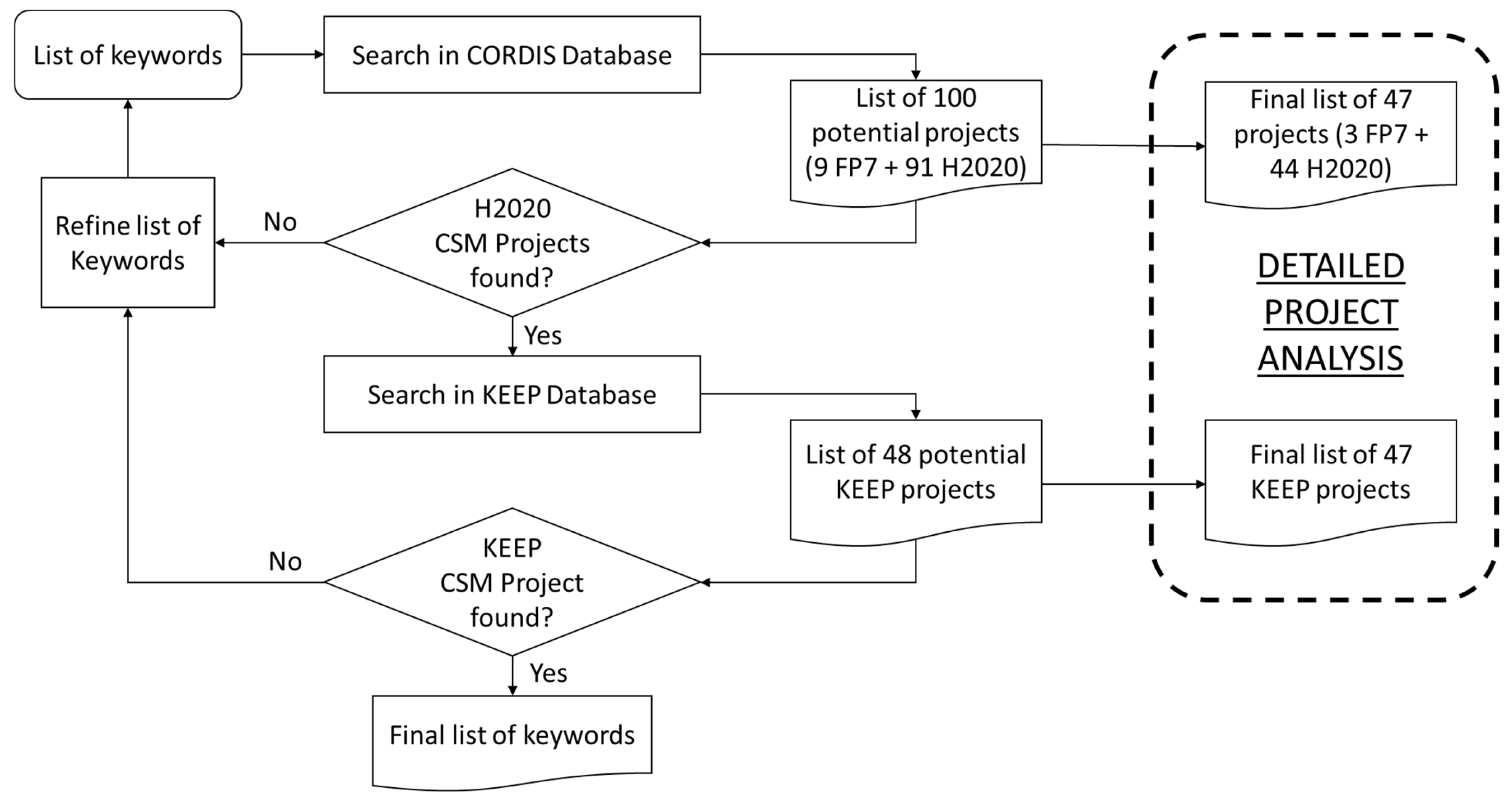


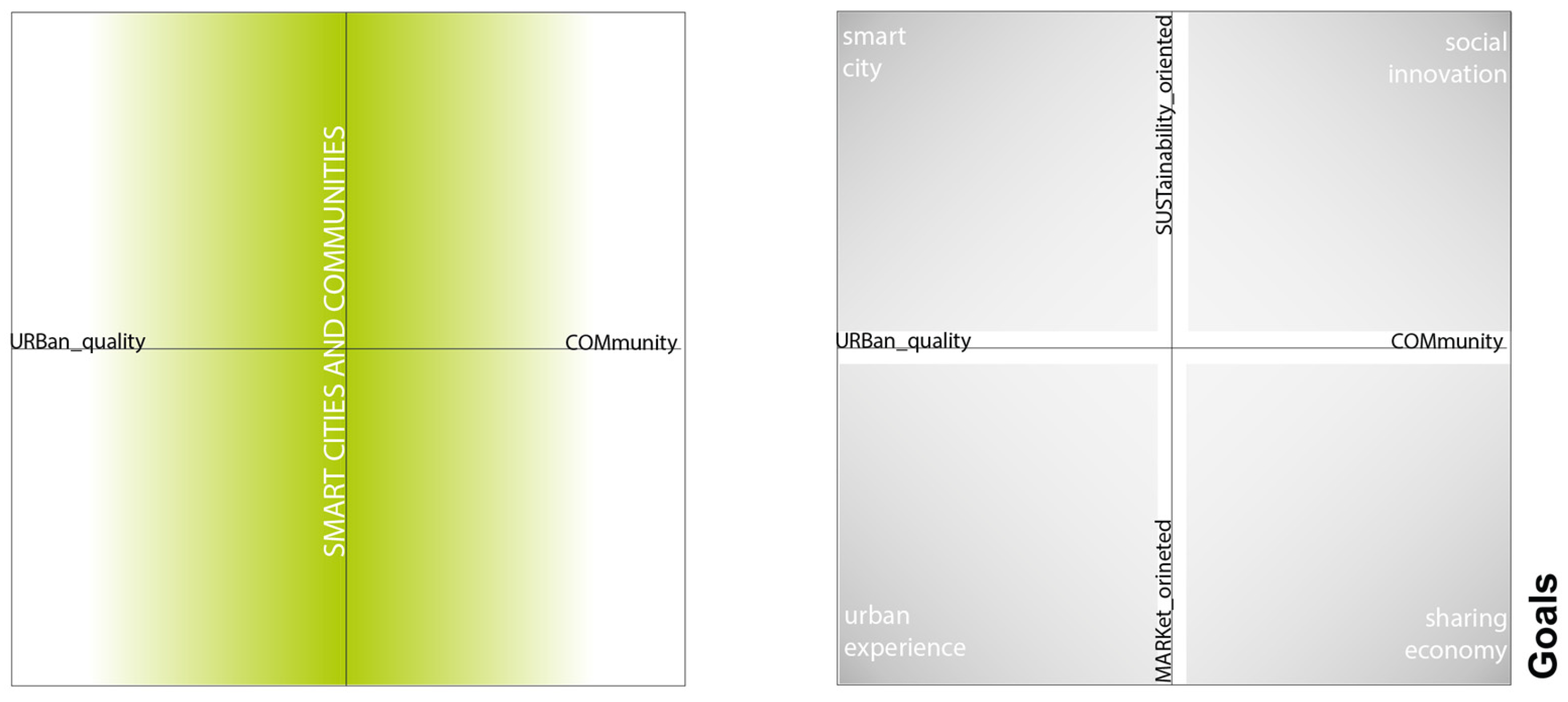
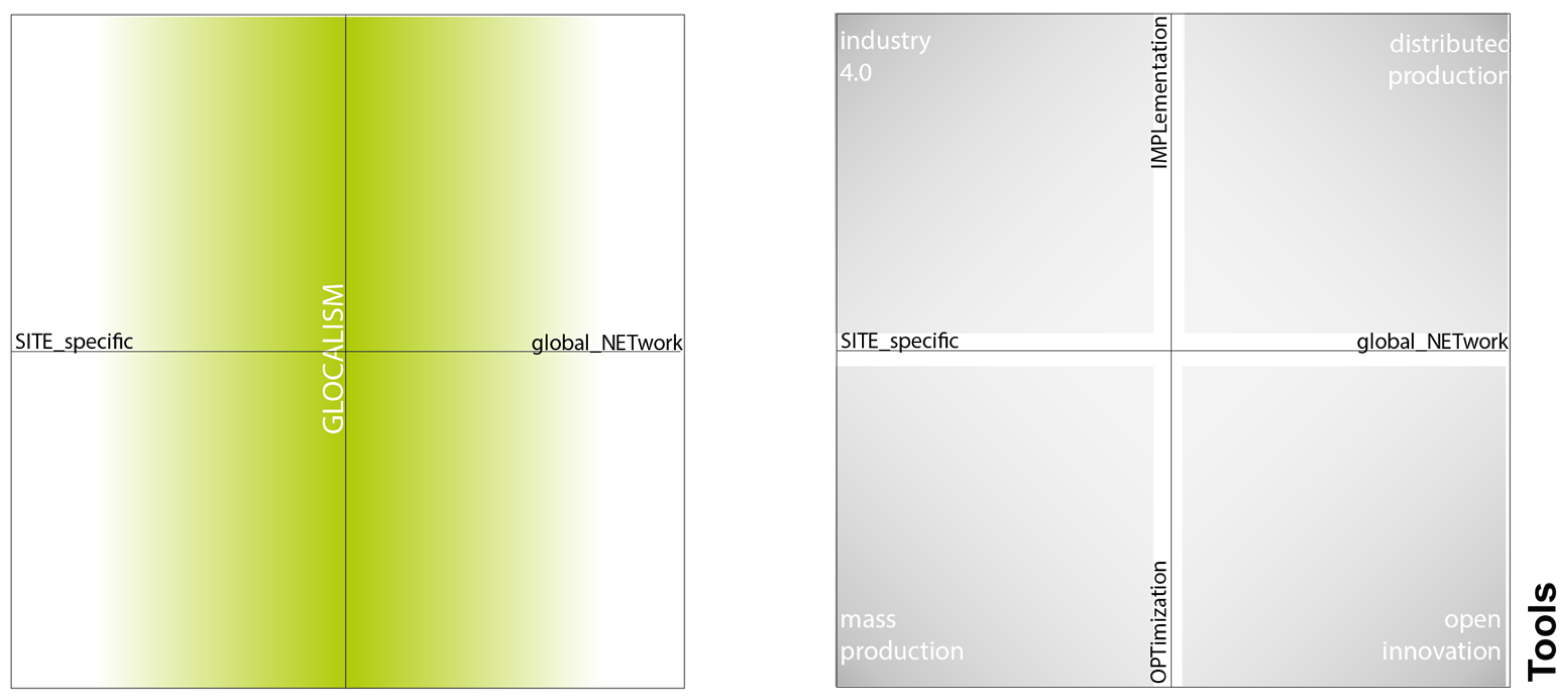

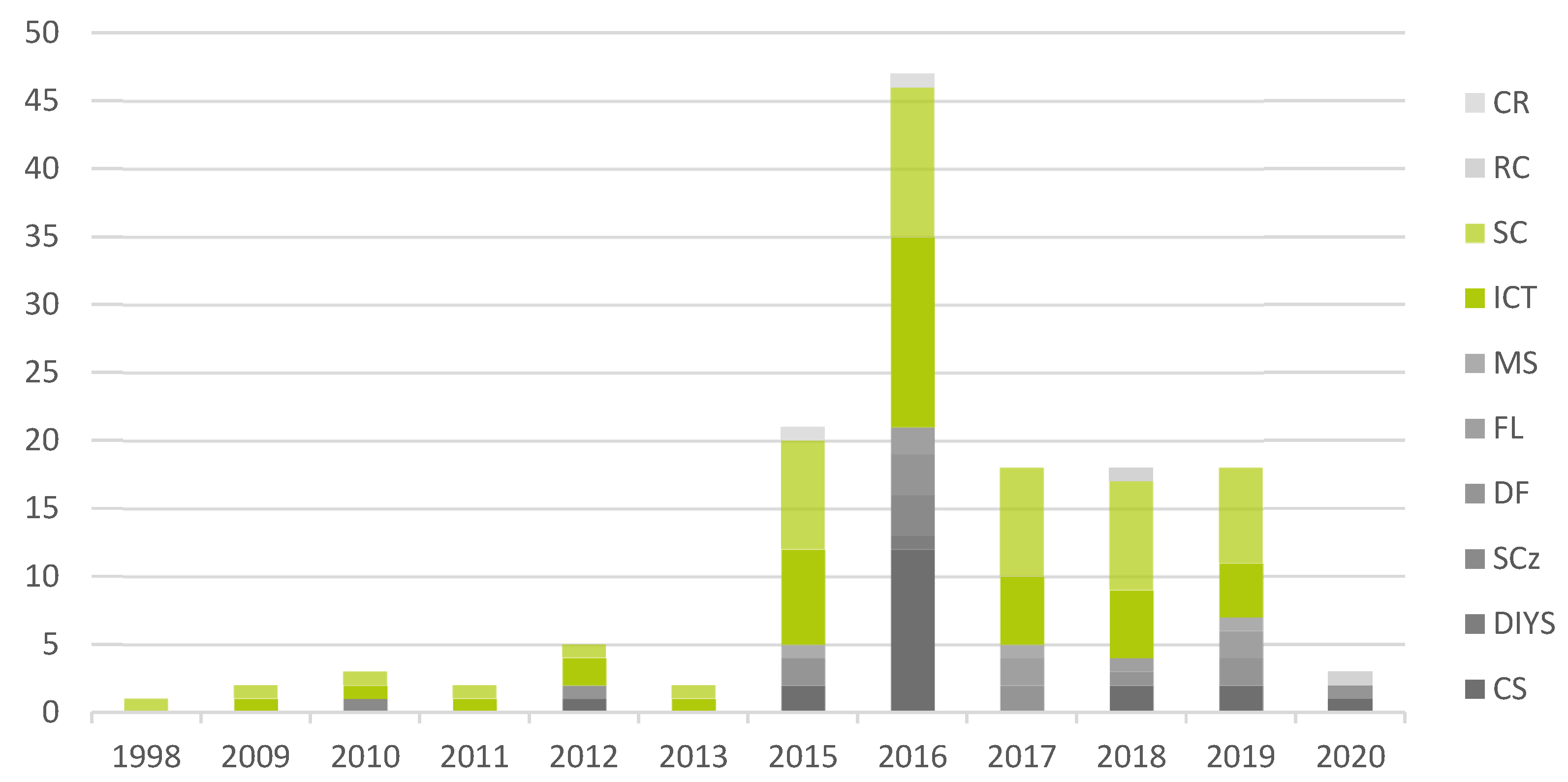
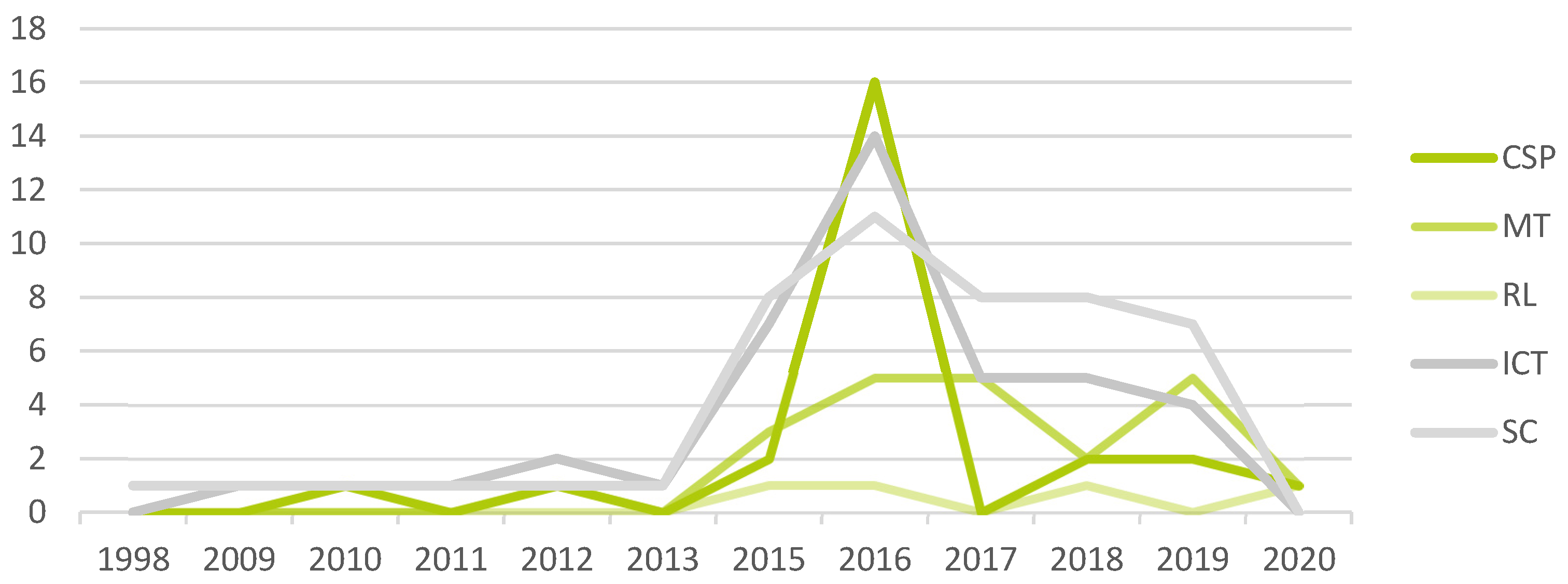

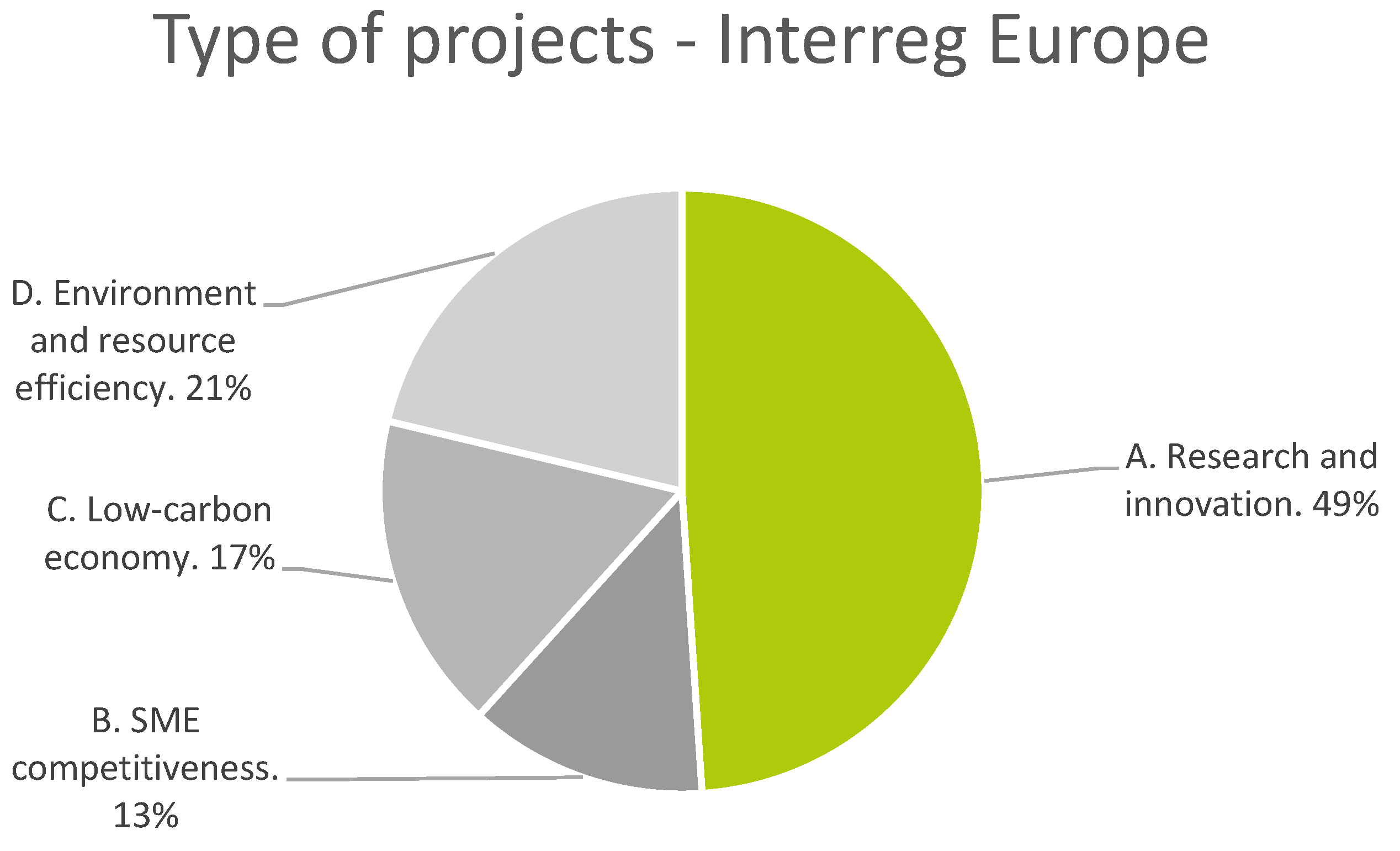
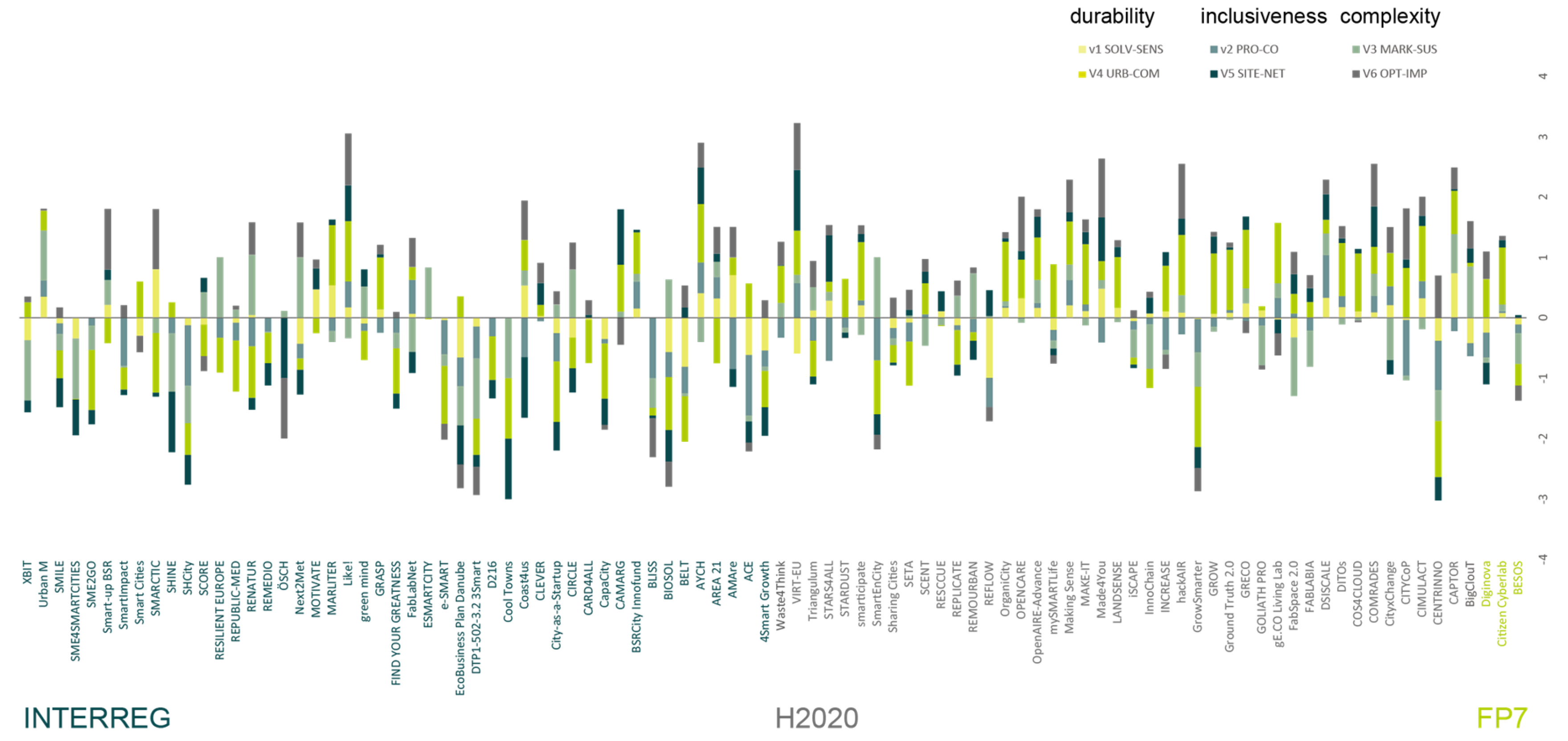

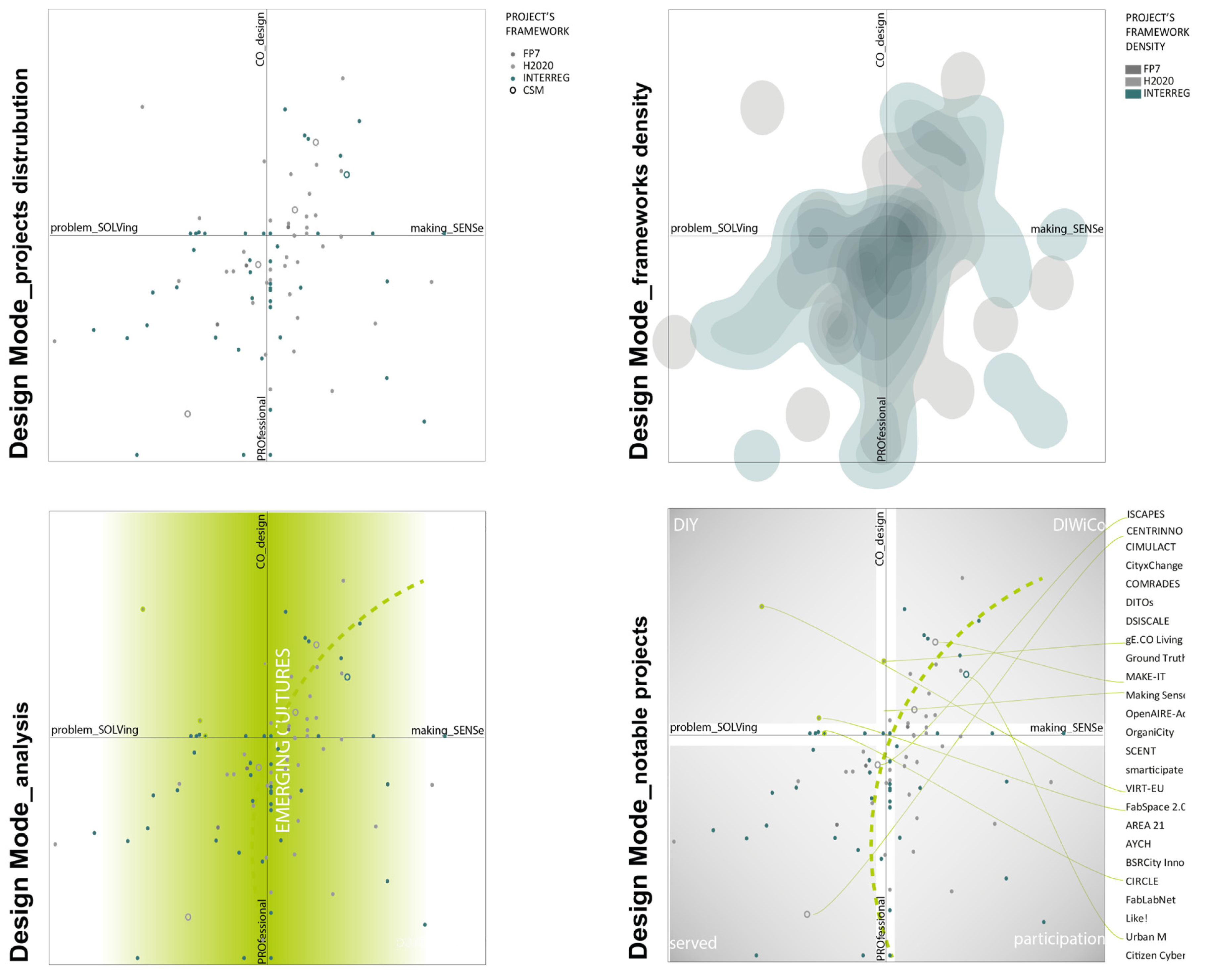

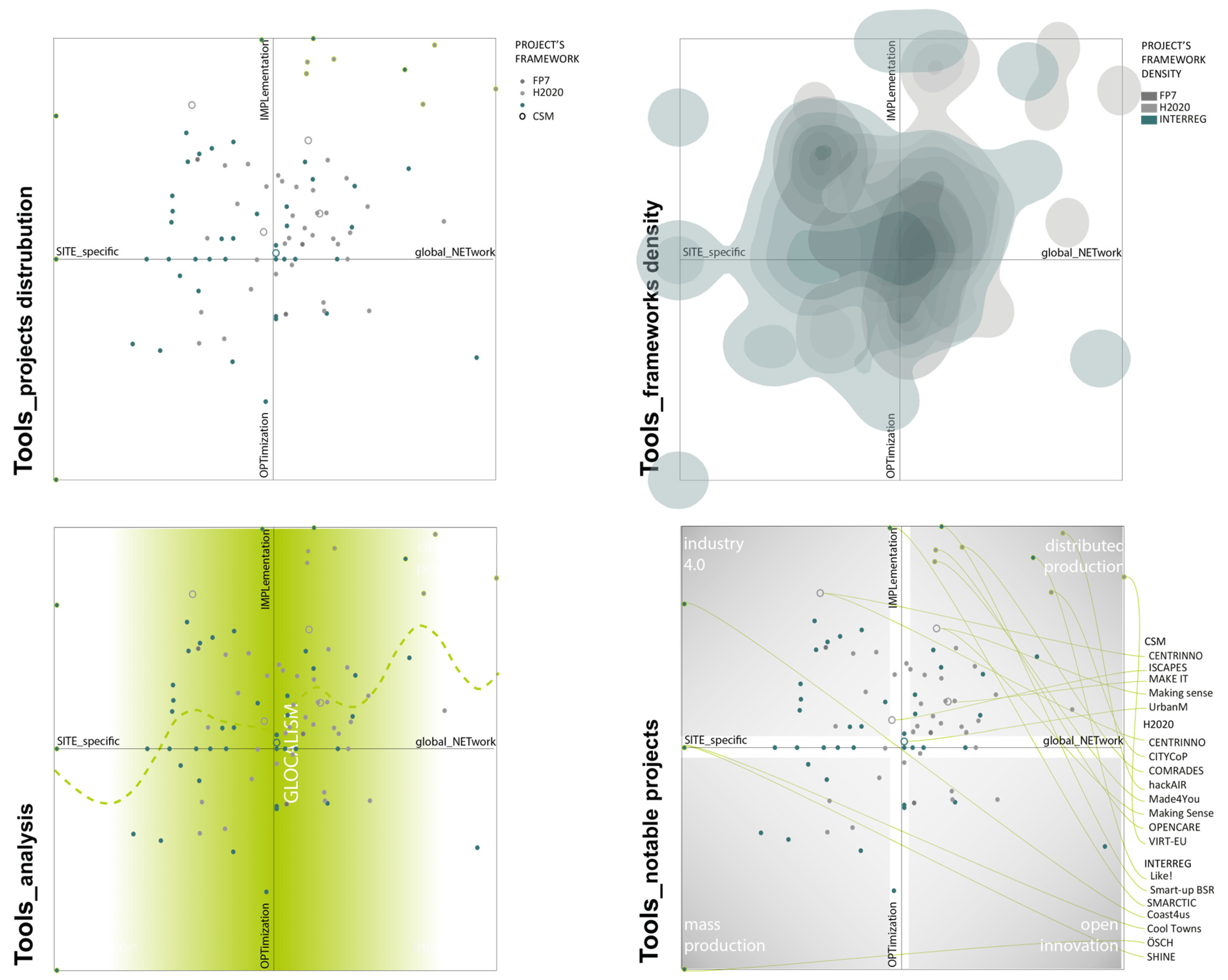
| CORDIS | KEEP | |
|---|---|---|
| BASIC | Acronym | Acronym |
| Title | Project Name | |
| Start Date | Project Start | |
| End Date | Project End | |
| EuroSciVoc | ||
| CALL | Program | Program |
| Framework Program | ||
| Topics | ||
| Call | Call | |
| FUND | Total Cost | |
| EC Max Contribution | Budget/EU Funding | |
| Funding Scheme | Co-Financing Sources | |
| DESCRIPTION | Project URL | |
| Objective | Description | |
| PARTICIPANTS | Coordinator (Entity) | Lead Partner |
| Coordinator Country | Country | |
| Participants (Entity) | Partners | |
| Participant Countries | Country Partners |
| Topic | Resilient Code | Sub-Code | Antagonist Code | Sub-Code |
|---|---|---|---|---|
| Inclusiveness | Community (C1) | Government * Service * Citizen * Participation * Education * Citizen Science | Urban Efficiency (C7) | Citizen Engagement Mobility * Energy Efficiency * Smart Grids * Infrastructures * Energy District * Open Spaces * Smart City |
| Co-Creation (C2) | Open Innovation Bottom Up Multistakeholder | Professional (C8) | Top-Down | |
| Durability | Making Sense (C3) | Social Innovation | Problem Solving (C9) | |
| Network (C4) | Platform | Site Specific (C10) | Replicability | |
| Complexity | Implementation (C5) | Trans-Disciplinary New Tool Digital Fabrication | Optimization (C11) | |
| Sustainability Oriented (C6) | Scenario * Sustainability * Policy * Resilience | Market Oriented (C12) | Lab * Industry * Tool * |
| Type of Project | No. of Projects | |
|---|---|---|
| A. Research and innovation. | (1) Strengthening research, technological development, and innovation. | 12 |
| (9, 10, 11) Social inclusion, education, and formation, Enhancement of public administrations | 11 | |
| B. SME competitiveness. | (3) Enhancing the competitiveness of SMEs. | 6 |
| C. Low-carbon economy. | (4) Supporting the shift towards a low-carbon economy in all sectors | 8 |
| D. Environment and resource efficiency. | (5) Promoting climate change adaptation, risk prevention, and management. | 3 |
| (6) Preserving and protecting the environment and promoting resource efficiency. | 5 | |
| (7) Promoting sustainable transport and removing bottlenecks in key network infrastructures. | 2 |
Disclaimer/Publisher’s Note: The statements, opinions and data contained in all publications are solely those of the individual author(s) and contributor(s) and not of MDPI and/or the editor(s). MDPI and/or the editor(s) disclaim responsibility for any injury to people or property resulting from any ideas, methods, instructions or products referred to in the content. |
© 2023 by the authors. Licensee MDPI, Basel, Switzerland. This article is an open access article distributed under the terms and conditions of the Creative Commons Attribution (CC BY) license (https://creativecommons.org/licenses/by/4.0/).
Share and Cite
Monaco, L.; Herce, C. Impact of Maker Movement on the Urban Resilience Development: Assessment Methodology and Analysis of EU Research and Innovation Projects. Sustainability 2023, 15, 12856. https://doi.org/10.3390/su151712856
Monaco L, Herce C. Impact of Maker Movement on the Urban Resilience Development: Assessment Methodology and Analysis of EU Research and Innovation Projects. Sustainability. 2023; 15(17):12856. https://doi.org/10.3390/su151712856
Chicago/Turabian StyleMonaco, Lina, and Carlos Herce. 2023. "Impact of Maker Movement on the Urban Resilience Development: Assessment Methodology and Analysis of EU Research and Innovation Projects" Sustainability 15, no. 17: 12856. https://doi.org/10.3390/su151712856
APA StyleMonaco, L., & Herce, C. (2023). Impact of Maker Movement on the Urban Resilience Development: Assessment Methodology and Analysis of EU Research and Innovation Projects. Sustainability, 15(17), 12856. https://doi.org/10.3390/su151712856







